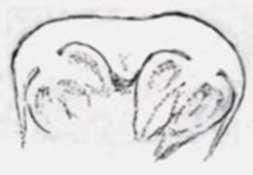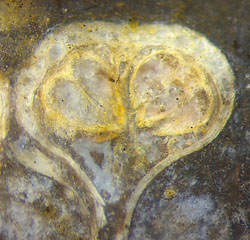Maggot ferns from Sardinia and Saxony
- surprisingly similar and different
Permian tree ferns with big
fronds whose small pinnules known as Scolecopteris
found
world-wide well-preserved in chert are usually sorted into about two
dozen species [1]. One of them, found in chert on Sardinia, looks
rather similar to Scolecopteris elegans (Figs.1,2),
first
discovered in Saxony in 18th century, first scientifically described
in 1837 [2] and 1874 [3], and questionably described anew by means of
three allegedly typical samples in 2016 [4]. A more careful look at
the three selected samples reveals that they have been ill-chosen for
the present purpose as they clearly show features of two different
species, thus causing confusion instead of defining the true Sc.
elegans.
As a distinct feature of Sc. elegans, the
pedicels bearing the synangia are much shorter than wide (Fig.1) and
hence their position and orientation to the cut plane is seldom
incidentally such that they are readily seen as in Figs.1-3, which
have been selected from a large number of pictures.


 Fig.1
(far left): Scolecopteris elegans
pinnule cross-section with the seldom seen pedicels bearing the
synangia, drawn after the lectotype in [5]. Image width 2mm.
Fig.1
(far left): Scolecopteris elegans
pinnule cross-section with the seldom seen pedicels bearing the
synangia, drawn after the lectotype in [5]. Image width 2mm.
Fig.2:
Sc. section closely resembling the lectotype. Image
width
2mm.
Fig.3:
Sc. sections, pedicel seen on the
right. Image width
4.3mm.
Complications
arise from the fact that one characteristic feature
of Sc. elegans, the narrow gap between the
sporangia and the
pinnule, which appears dark in Fig.2 and pale on the far right in
Fig.3, is seen on some other species, too. In cases where other
distinctive features are not available, the fossil cannot
be assigned to an established species. This applies to Fig.3, which has
been taken from a sample presented in
Permian
Chert News 1, there Fig.7, whose
venation
pattern differs from that of Sc. elegans.
By comparing Figs.1-3 with Figs.4-6,
one may arrive at the conclusion that the similarities outweigh the
differences. Hence, the "maggot fern" from Sardinia is similar to two
(or more ?) species from Saxony. With such state of things one could be
satisfied if
there were not the confusing claim in [4], p. 226, that the sample
Bu8/18 (with big pedicels) be
representative of Sc. elegans. Apparently the author had
overlooked the big pedicels bearing the
synangia.



Figs.4,5:
Scolecopteris pinnule
cross-sections on the raw surface of a chert fragment found at
Perdasdefogu. Image width 2mm.
Fig.6: Same sample as Figs.4,5,
row of
synangia . Image
width 2mm.
Fig.7(right): Scolecopteris pinnule half with one
synangium on a big pedicel, with spores inside the two sporangia seen
here on a cut face; disputed specimen from Saxony. Image
width 1.5mm.
Note that Figs.4-6 show the raw surface while Figs.1-3,7
have been taken from cut faces.
Lots of chert samples with Scolecopteris recovered
in the 1990s have been stored away and not even looked at. Hence it is
well possible
that more surprises will be found when the
samples are thoroughly investigated.
So
it turns out
that the surprising difference mentioned
above is not due to the different locations but to distinctly different
features of two species from the same location, the maggot stone site
in the Doehlen basin in Saxony. The difference becomes obvious
by comparing the two images in
Permian
Chert News 34.
Samples from Doehlen basin: Fig.2: Bu7/89 (4.69kg) Part2,
found by Schiefner in
2000; Fig.3: H2/35 Part1, found near Haenichen in
1993;
Fig.7:
Bu8/18,
found by Ulrich Wagner (Dresden)
at
Freital-Burgk
in 1997;
Samples
from Sardinia:
Figs.4,5,6: Pd/2.1, found near Perdasdefogu in 2009.
H.-J.
Weiss 2021
[1] M.A. Millay:
A review of permineralized Euramerican Carboniferous tree
ferns. Rev. Palaeobot. Palyn. 95(1997), 191-209.
[2] E. Zenker:
Scolecopteris elegans, ein neues fossiles Farrngewächs mit
Fructification. Linnaea 11(1837), 509-12.
[3] E. Strasburger:
Über Scolecopteris elegans ..., Jenaische Z. Nat. N.F.1 Jena 8(1874),
81-95.
[4] M. Barthel:
Die Rotliegendflora der Döhlen-Formation. Geologica Saxonica 61 (2)
(2015, released in 2016), 105-238.
[5]
M.
Barthel,
W. Reichel, H.-J. Weiss:
"Madensteine" in Sachsen. Abhandl. Staatl. Mus.
Mineral. Geol. Dresden 41(1995), 117-135, Table 1.
|
 |
 35 35 |



 Fig.1
(far left): Scolecopteris elegans
pinnule cross-section with the seldom seen pedicels bearing the
synangia, drawn after the lectotype in [5]. Image width 2mm.
Fig.1
(far left): Scolecopteris elegans
pinnule cross-section with the seldom seen pedicels bearing the
synangia, drawn after the lectotype in [5]. Image width 2mm. 




 35
35